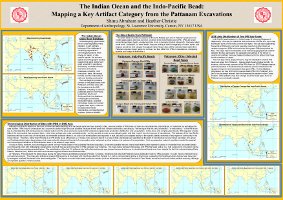| Authors | Shinu Abraham, Heather Christie |
| Title | The Indian Ocean and the Indo-Pacific Bead - Mapping a Key Artifact Category from the Pattanam Excavations |
Abstract
A technical examination of artistic decoration from the Buddhist temple complex at Nako, North India.
The major scope of an ongoing scientific study of the supports and painting materials used in the Nako temple complex has been focused on the technical examination of wall paintings and polychromy of the clay sculptures.
A substantial part of the Buddhist temple complex in Nako, Western Himalaya region, North India can be dated back to the period of its foundation at the end of the 11 th and beginning of the 12 th century. Boasting four temples this complex preserves the earliest artistic heritage of the Tibetan Buddhism in the form of mural paintings, polychrome clay sculptures and painted ceiling panels. This pape r is dealing with the preliminary results of the examination of two sets of polychromed sculptures belonging to the original temple decoration from the Translator's Temple (Lotsawa Lhakhang) and the Upper Temple (Lhakhang Gongma). Since the sculptures from both tem ples are nowadays heavily overpainted, the study was focused on revealing of the appearance and material composition of th e original polychromy and the comparison with materials used in later interventions.
While the walls of Lotsawa Lhakhang and Lhakhang Gongma are still decorated with the original wall paintings, two smaller temples Karchung Lhakhang and Gyagpagpa Lhakhang have been extensively overpainted. These secondary paintings have never been studied from the materiality point of view until now. Overview of the support composition and painting materials used for the original and secondary mural paintings will be presented and discussed. A better understanding of the painting technology of the temple complex could be achieved through this comparison and may be also relevant for further cultural studies in this area.
